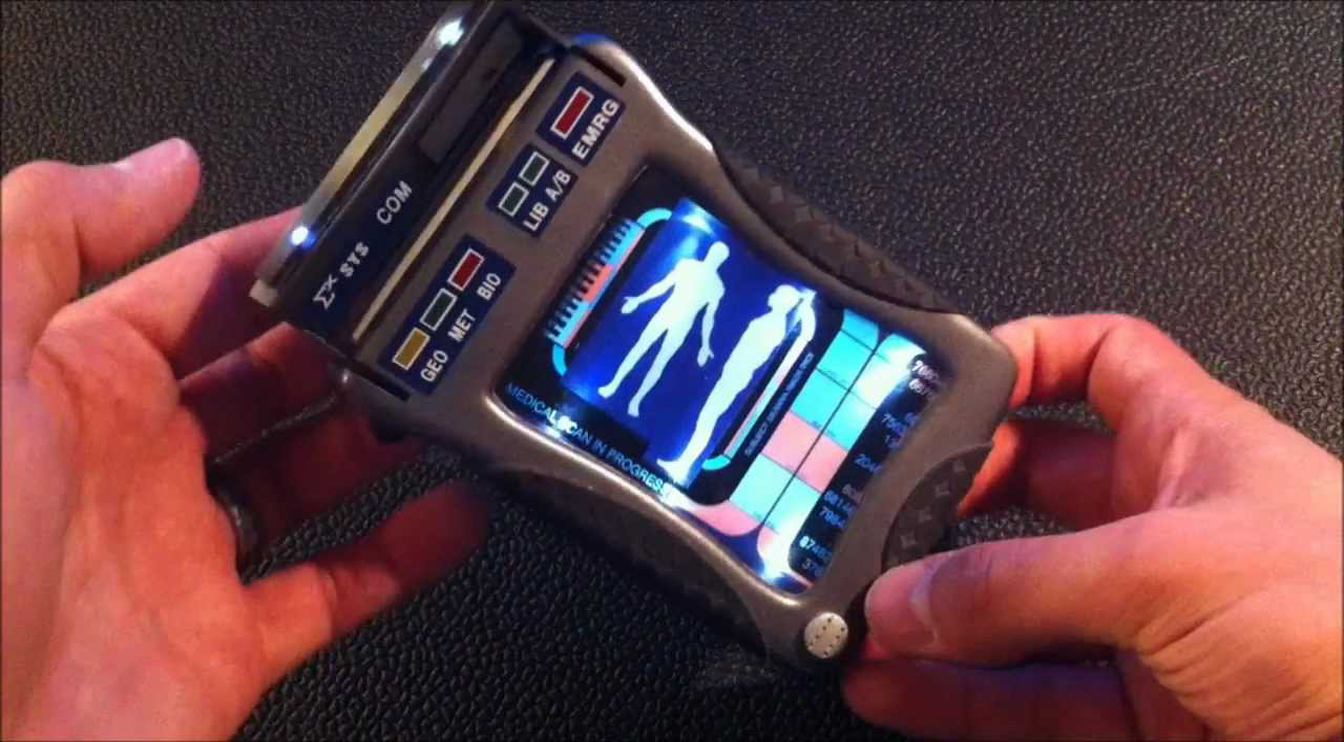
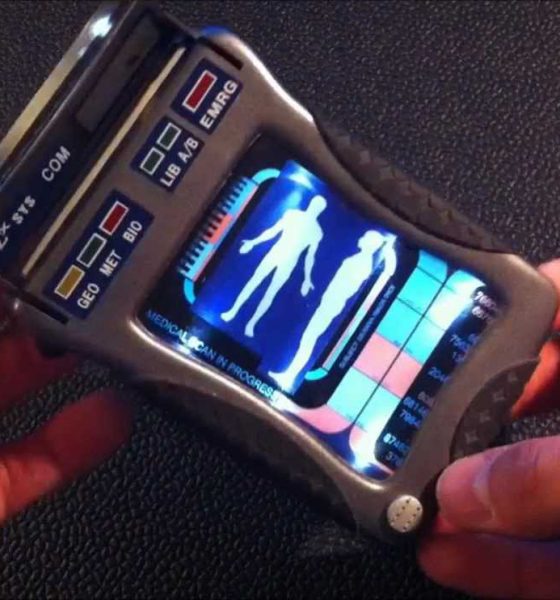
News
Mars travelers can use ‘Star Trek’ Tricorder-like features using smartphone biotech: study
Plans to take humans to the Moon and Mars come with numerous challenges, and the health of space travelers is no exception. One of the ways any ill-effects can be prevented or mitigated is by detecting relevant changes in the body and the body’s surroundings, something that biosensor technology is specifically designed to address on Earth. However, the small size and weight requirements for tech used in the limited habitats of astronauts has impeded its development to date.
A recent study of existing smartphone-based biosensors by scientists from Queen’s University Belfast (QUB) in the UK identified several candidates under current use or development that could be also used in a space or Martian environment. When combined, the technology could provide functionality reminiscent of the “Tricorder” devices used for medical assessments in the Star Trek television and movie franchises, providing on-site information about the health of human space travelers and biological risks present in their habitats.
Biosensors focus on studying biomarkers, i.e., the body’s response to environmental conditions. For example, changes in blood composition, elevations of certain molecules in urine, heart rate increases or decreases, and so forth, are all considered biomarkers. Health and fitness apps tracking general health biomarkers have become common in the marketplace with brands like FitBit leading the charge for overall wellness sensing by tracking sleep patterns, heart rate, and activity levels using wearable biosensors. Astronauts and other future space travelers could likely use this kind of tech for basic health monitoring, but there are other challenges that need to be addressed in a compact way.
The projected human health needs during spaceflight have been detailed by NASA on its Human Research Program website, more specifically so in its web-based Human Research Roadmap (HRR) where the agency has its scientific data published for public review. Several hazards of human spaceflight are identified, such as environmental and mental health concerns, and the QUB scientists used that information to organize their study. Their research produced a 20-page document reviewing the specific inner workings of the relevant devices found in their searches, complete with tables summarizing each device’s methods and suitability for use in space missions. Here are some of the highlights.
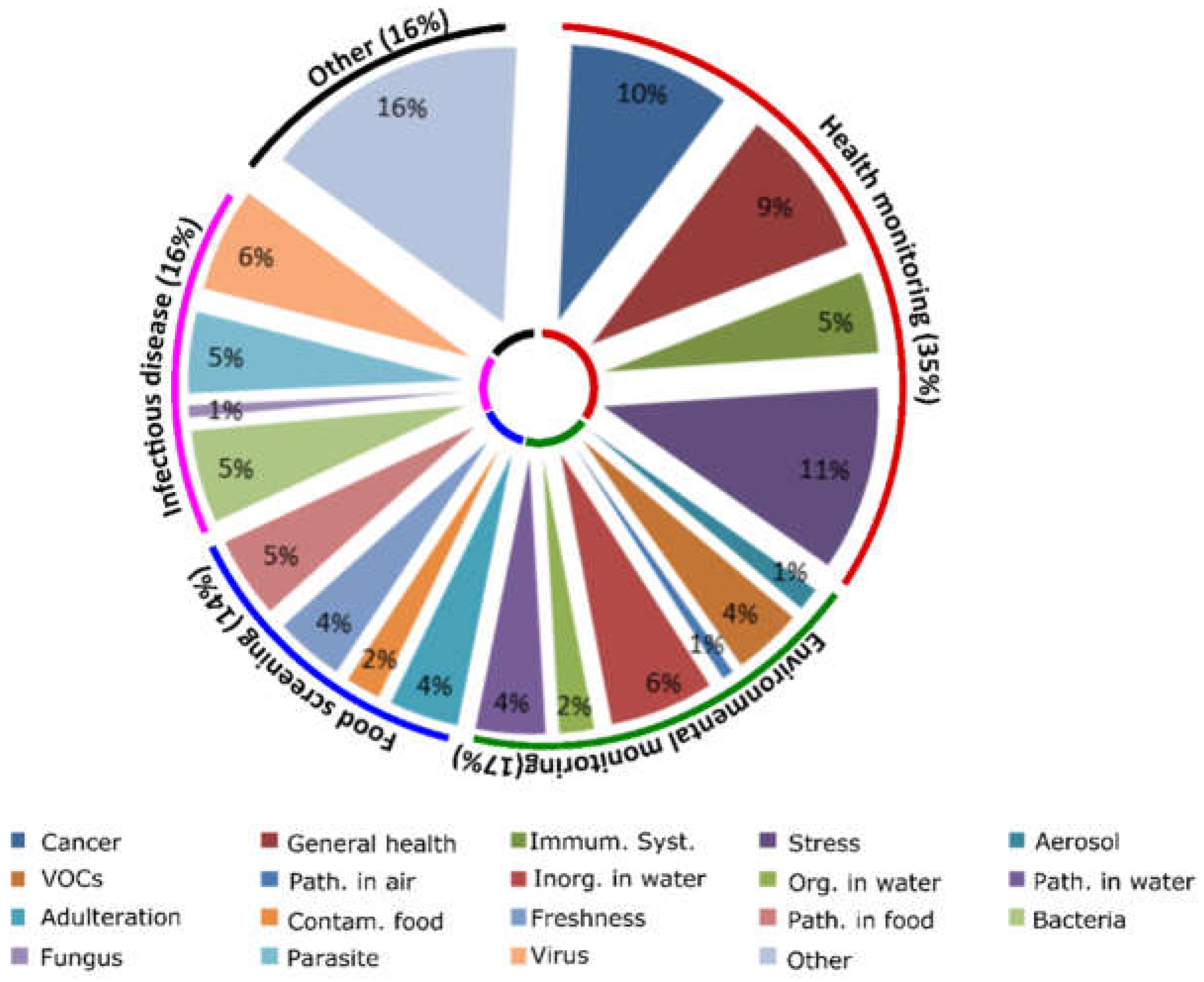
Risks in the Spacecraft Environment
During spaceflight, the environment is a closed system that has a two-fold effect: One, the immune system has been shown to decrease its functionality in long-duration missions, specifically by lowering white blood cell counts, and two, the weightless and non-competitive environment make it easier for microbes to transfer between humans and their growth rates increase. In one space shuttle era study, the number of microbial cells in the vehicle able to reproduce increased by 300% within 12 days of being in orbit. Also, certain herpes viruses, such as those responsible for chickenpox and mononucleosis, have been reactivated under microgravity, although the astronauts typically didn’t show symptoms despite the presence of active viral shedding (the virus had surfaced and was able to spread).
Frequent monitoring of the spacecraft environment and the crew’s biomarkers is the best way to mitigate these challenges, and NASA is addressing these issues to an extent with traditional instruments and equipment to collect data, although often times the data cannot be processed until the experiments are returned to Earth. An attempt has also been made to rapidly quantify microorganisms aboard the International Space Station (ISS) via a handheld device called the Lab-on-a-Chip Application Development-Portable Test System (LOCAD-PTS). However, this device cannot distinguish between microorganism species yet, meaning it can’t tell the difference between pathogens and harmless species. The QUB study found several existing smartphone-based technologies generally developed for use in remote medical care facilities that could achieve better identification results.
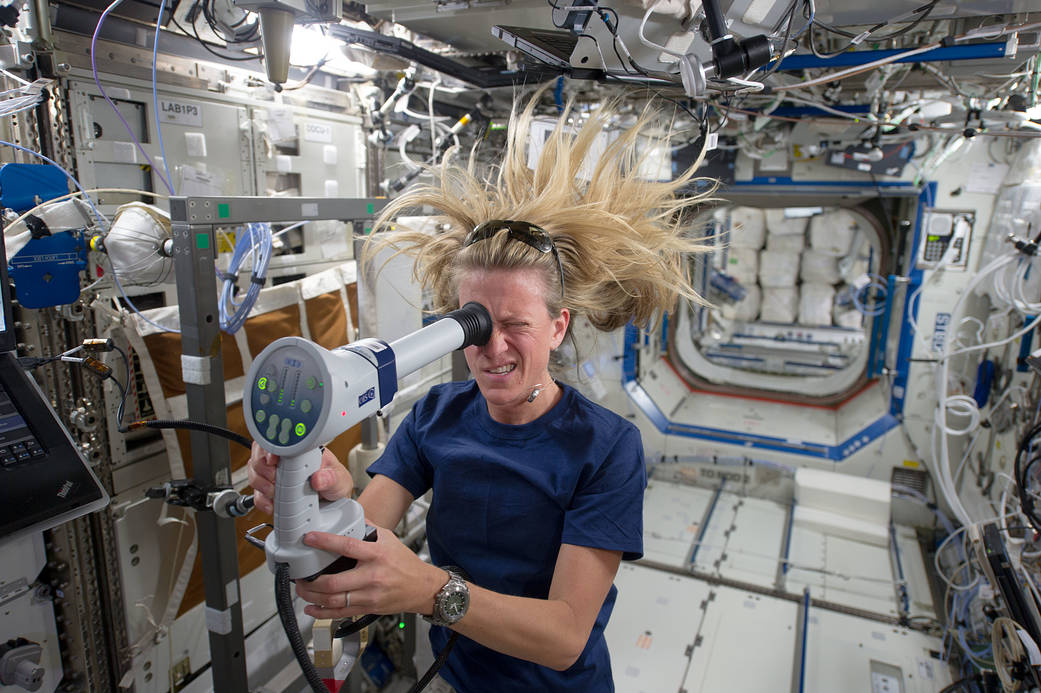
One of the devices described was a spectrometer (used to identify substances based on the light frequency emitted) which used the smartphone’s flashlight and camera to generate data that was at least as accurate as traditional instruments. Another was able to identify concentrations of an artificial growth hormone injected into cows called recominant bovine somatrotropin (rBST) in test samples, and other systems were able to accurately detect cyphilis and HIV as well as the zika, chikungunya, and dengue viruses. All of the devices used smartphone attachments, some of them with 3D-printed parts. Of course, the types of pathogens detected are not likely to be common in a closed space habitat, but the technology driving them could be modified to meet specific detection needs.
The Stress of Spaceflight
A group of people crammed together in a small space for long periods of time will be impacted by the situation despite any amount of careful selection or training due to the isolation and confinement. Declines in mood, cognition, morale, or interpersonal interaction can impact team functioning or transition into a sleep disorder. On Earth, these stress responses may seem common, or perhaps an expected part of being human, but missions in deep space and on Mars will be demanding and need fully alert, well-communicating teams to succeed. NASA already uses devices to monitor these risks while also addressing the stress factor by managing habitat lighting, crew movement and sleep amounts, and recommending astronauts keep journals to vent as needed. However, an all-encompassing tool may be needed for longer-duration space travels.
As recognized by the QUB study, several “mindfulness” and self-help apps already exist in the market and could be utilized to address the stress factor in future astronauts when combined with general health monitors. For example, the popular FitBit app and similar products collect data on sleep patterns, activity levels, and heart rates which could potentially be linked to other mental health apps that could recommend self-help programs using algorithms. The more recent “BeWell” app monitors physical activity, sleep patterns, and social interactions to analyze stress levels and recommend self-help treatments. Other apps use voice patterns and general phone communication data to assess stress levels such as “StressSense” and “MoodSense”.
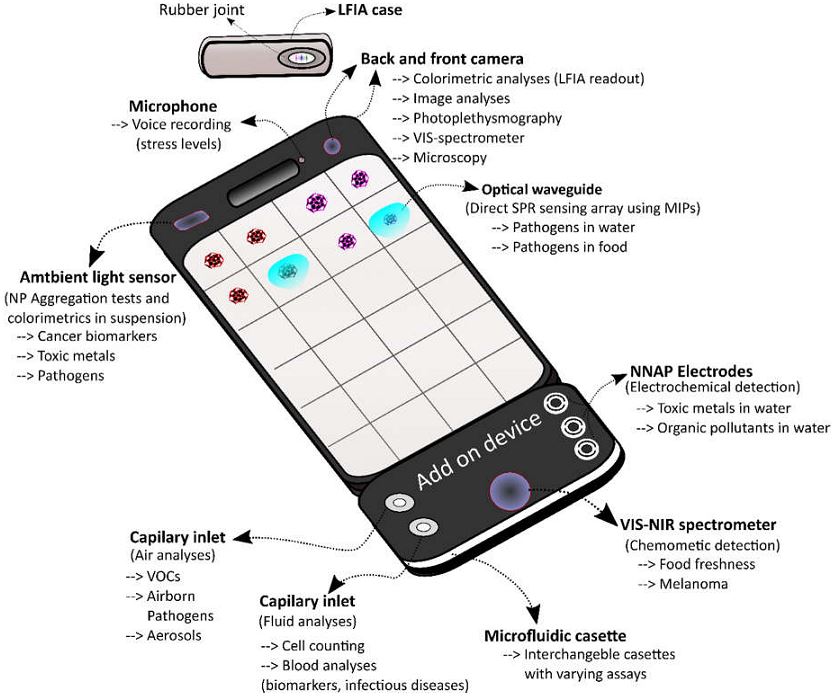
Advances in smartphone technology such as high resolution cameras, microphones, fast processing speed, wireless connectivity, and the ability to attach external devices provide tools that can be used for an expanding number of “portable lab” type functionalities. Unfortunately, though, despite the possibilities that these biosensors could mean for human spaceflight needs, there are notable limitations that would need to be overcome in some of the devices. In particular, any device utilizing antibodies or enzymes in its testing would risk the stability of its instruments thanks to radiation from galactic cosmic rays and solar particle events. Biosensor electronics might also be damaged by these things as well. Development of new types of shielding may be necessary to ensure their functionality outside of Earth and Earth orbit or, alternatively, synthetic biology could also be a source of testing elements genetically engineered to withstand the space and Martian environments.
The interest in smartphone-based solutions for space travelers has been garnering more attention over the years as tech-centric societies have moved in the “app” direction overall. NASA itself has hosted a “Space Apps Challenge” for the last 8 years, drawing thousands of participants to submit programs that interpret and visualize data for greater understanding of designated space and science topics. Some of the challenges could be directly relevant to the biosensor field. For example, in the 2018 event, contestants are asked to develop a sensor to be used by humans on Mars to observe and measure variables in their environments; in 2017, contestants created visualizations of potential radiation exposure during polar or near-polar flight.
While the QUB study implied that the combination of existing biosensor technology could be equivalent to a Tricorder, the direct development of such a device has been the subject of its own specific challenge. In 2012, the Qualcomm Tricorder XPRIZE competition was launched, asking competitors to develop a user-friendly device that could accurately diagnose 13 health conditions and capture 5 real-time health vital signs. The winner of the prize awarded in 2017 was Pennsylvania-based family team called Final Frontier Medical Devices, now Basil Leaf Technologies, for their DxtER device. According to their website, the sensors inside DxtER can be used independently, one of which is in a Phase 1 Clinical Trial. The second place winner of the competition used a smartphone app to connect its health testing modules and generate a diagnosis from the data acquired from the user.
The march continues to develop the technology humans will need to safely explore regions beyond Earth orbit. Space is hard, but it was hard before we went there the first time, and it was hard before we put humans on the moon. There may be plenty of challenges to overcome, but as the Queen’s University Belfast study demonstrates, we may already be solving them. It’s just a matter of realizing it and expanding on it.

News
Tesla Full Self-Driving v14.2 – Full Review, the Good and the Bad

Tesla rolled out Full Self-Driving version 14.2 yesterday to members of the Early Access Program (EAP). Expectations were high, and Tesla surely delivered.
With the rollout of Tesla FSD v14.2, there were major benchmarks for improvement from the v14.1 suite, which spanned across seven improvements. Our final experience with v14.1 was with v14.1.7, and to be honest, things were good, but it felt like there were a handful of regressions from previous iterations.
While there were improvements in brake stabbing and hesitation, we did experience a few small interventions related to navigation and just overall performance. It was nothing major; there were no critical takeovers that required any major publicity, as they were more or less subjective things that I was not particularly comfortable with. Other drivers might have been more relaxed.
With v14.2 hitting our cars yesterday, there were a handful of things we truly noticed in terms of improvement, most notably the lack of brake stabbing and hesitation, a major complaint with v14.1.x.
However, in a 62-minute drive that was fully recorded, there were a lot of positives, and only one true complaint, which was something we haven’t had issues with in the past.
The Good
Lack of Brake Stabbing and Hesitation
Perhaps the most notable and publicized issue with v14.1.x was the presence of brake stabbing and hesitation. Arriving at intersections was particularly nerve-racking on the previous version simply because of this. At four-way stops, the car would not be assertive enough to take its turn, especially when other vehicles at the same intersection would inch forward or start to move.
This was a major problem.
However, there were no instances of this yesterday on our lengthy drive. It was much more assertive when arriving at these types of scenarios, but was also more patient when FSD knew it was not the car’s turn to proceed.
Can report on v14.2 today there were ZERO instances of break stabbing or hesitation at intersections today
It was a significant improvement from v14.1.x
— TESLARATI (@Teslarati) November 21, 2025
This improvement was the most noticeable throughout the drive, along with fixes in overall smoothness.
Speed Profiles Seem to Be More Reasonable
There were a handful of FSD v14 users who felt as if the loss of a Max Speed setting was a negative. However, these complaints will, in our opinion, begin to subside, especially as things have seemed to be refined quite nicely with v14.2.
Freeway driving is where this is especially noticeable. If it’s traveling too slow, just switch to a faster profile. If it’s too fast, switch to a slower profile. However, the speeds seem to be much more defined with each Speed Profile, which is something that I really find to be a huge advantage. Previously, you could tell the difference in speeds, but not in driving styles. At times, Standard felt a lot like Hurry. Now, you can clearly tell the difference between the two.
It seems as if Tesla made a goal that drivers should be able to tell which Speed Profile is active if it was not shown on the screen. With v14.1.x, this was not necessarily something that could be done. With v14.2, if someone tested me on which Speed Profile was being used, I’m fairly certain I could pick each one.
Better Overall Operation
I felt, at times, especially with v14.1.7, there were some jerky movements. Nothing that was super alarming, but there were times when things just felt a little more finicky than others.
v14.2 feels much smoother overall, with really great decision-making, lane changes that feel second nature, and a great speed of travel. It was a very comfortable ride.
The Bad
Parking
It feels as if there was a slight regression in parking quality, as both times v14.2 pulled into parking spots, I would have felt compelled to adjust manually if I were staying at my destinations. For the sake of testing, at my first destination, I arrived, allowed the car to park, and then left. At the tail-end of testing, I walked inside the store that FSD v14.2 drove me to, so I had to adjust the parking manually.
This was pretty disappointing. Apart from parking at Superchargers, which is always flawless, parking performance is something that needs some attention. The release notes for v14.2. state that parking spot selection and parking quality will improve with future versions.
Any issues with parking on your end? 14.1.7 didn’t have this trouble with parking pic.twitter.com/JPLRO2obUj
— TESLARATI (@Teslarati) November 21, 2025
However, this was truly my only complaint about v14.2.
You can check out our full 62-minute ride-along below:
Elon Musk
SpaceX issues statement on Starship V3 Booster 18 anomaly
The incident unfolded during gas-system pressure testing at the company’s Massey facility in Starbase, Texas.

SpaceX has issued an initial statement about Starship Booster 18’s anomaly early Friday. The incident unfolded during gas-system pressure testing at the company’s Massey facility in Starbase, Texas.
SpaceX’s initial comment
As per SpaceX in a post on its official account on social media platform X, Booster 18 was undergoing gas system pressure tests when the anomaly happened. Despite the nature of the incident, the company emphasized that no propellant was loaded, no engines were installed, and personnel were kept at a safe distance from the booster, resulting in zero injuries.
“Booster 18 suffered an anomaly during gas system pressure testing that we were conducting in advance of structural proof testing. No propellant was on the vehicle, and engines were not yet installed. The teams need time to investigate before we are confident of the cause. No one was injured as we maintain a safe distance for personnel during this type of testing. The site remains clear and we are working plans to safely reenter the site,” SpaceX wrote in its post on X.
Incident and aftermath
Livestream footage from LabPadre showed Booster 18’s lower half crumpling around the liquid oxygen tank area at approximately 4:04 a.m. CT. Subsequent images posted by on-site observers revealed extensive deformation across the booster’s lower structure. Needless to say, spaceflight observers have noted that Booster 18 would likely be a complete loss due to its anomaly.
Booster 18 had rolled out only a day earlier and was one of the first vehicles in the Starship V3 program. The V3 series incorporates structural reinforcements and reliability upgrades intended to prepare Starship for rapid-reuse testing and eventual tower-catch operations. Elon Musk has been optimistic about Starship V3, previously noting on X that the spacecraft might be able to complete initial missions to Mars.
Investor's Corner
Tesla analyst maintains $500 PT, says FSD drives better than humans now
The team also met with Tesla leaders for more than an hour to discuss autonomy, chip development, and upcoming deployment plans.

Tesla (NASDAQ:TSLA) received fresh support from Piper Sandler this week after analysts toured the Fremont Factory and tested the company’s latest Full Self-Driving software. The firm reaffirmed its $500 price target, stating that FSD V14 delivered a notably smooth robotaxi demonstration and may already perform at levels comparable to, if not better than, average human drivers.
The team also met with Tesla leaders for more than an hour to discuss autonomy, chip development, and upcoming deployment plans.
Analysts highlight autonomy progress
During more than 75 minutes of focused discussions, analysts reportedly focused on FSD v14’s updates. Piper Sandler’s team pointed to meaningful strides in perception, object handling, and overall ride smoothness during the robotaxi demo.
The visit also included discussions on updates to Tesla’s in-house chip initiatives, its Optimus program, and the growth of the company’s battery storage business. Analysts noted that Tesla continues refining cost structures and capital expenditure expectations, which are key elements in future margin recovery, as noted in a Yahoo Finance report.
Analyst Alexander Potter noted that “we think FSD is a truly impressive product that is (probably) already better at driving than the average American.” This conclusion was strengthened by what he described as a “flawless robotaxi ride to the hotel.”
Street targets diverge on TSLA
While Piper Sandler stands by its $500 target, it is not the highest estimate on the Street. Wedbush, for one, has a $600 per share price target for TSLA stock.
Other institutions have also weighed in on TSLA stock as of late. HSBC reiterated a Reduce rating with a $131 target, citing a gap between earnings fundamentals and the company’s market value. By contrast, TD Cowen maintained a Buy rating and a $509 target, pointing to strong autonomous driving demonstrations in Austin and the pace of software-driven improvements.
Stifel analysts also lifted their price target for Tesla to $508 per share over the company’s ongoing robotaxi and FSD programs.








